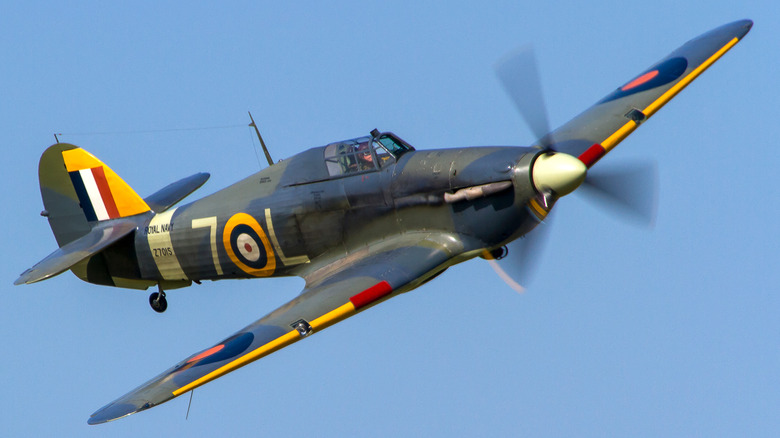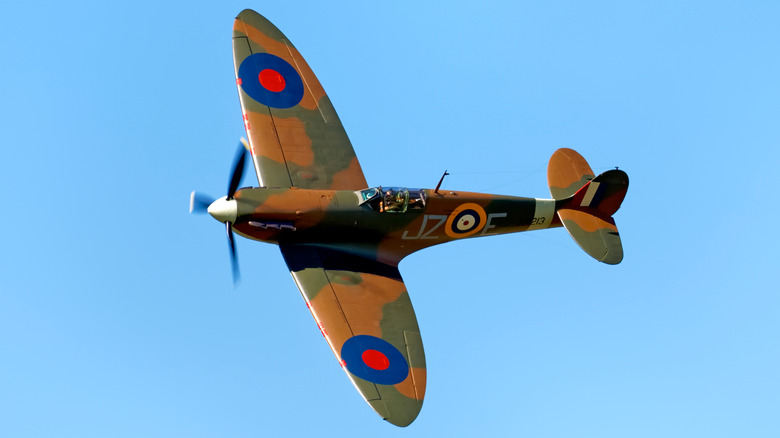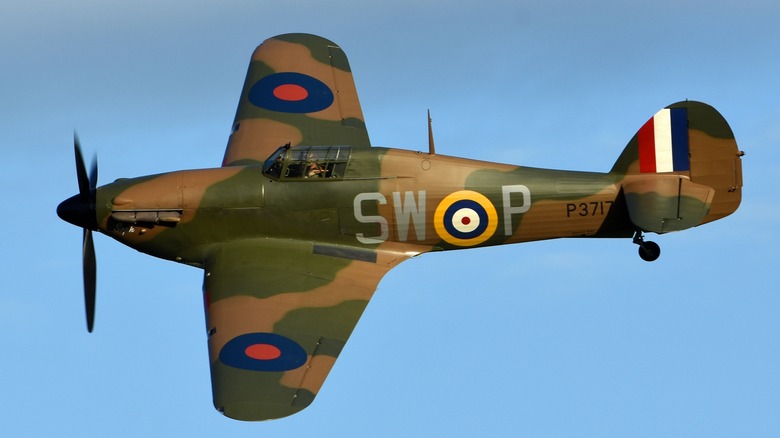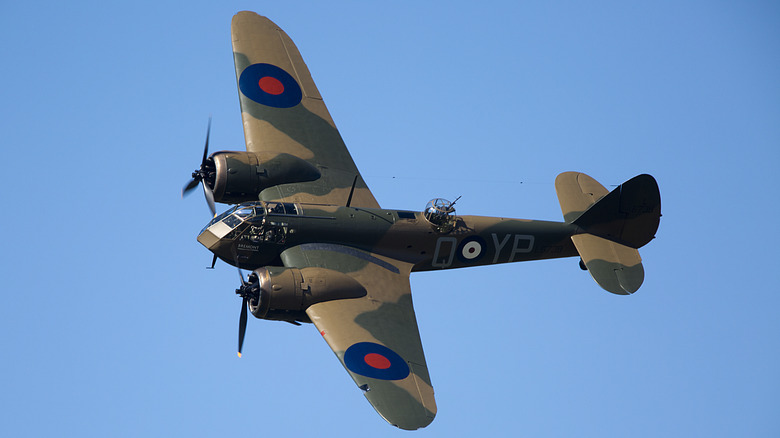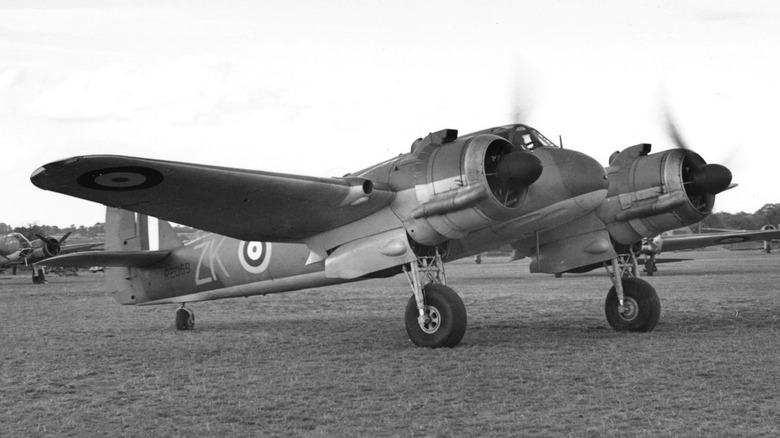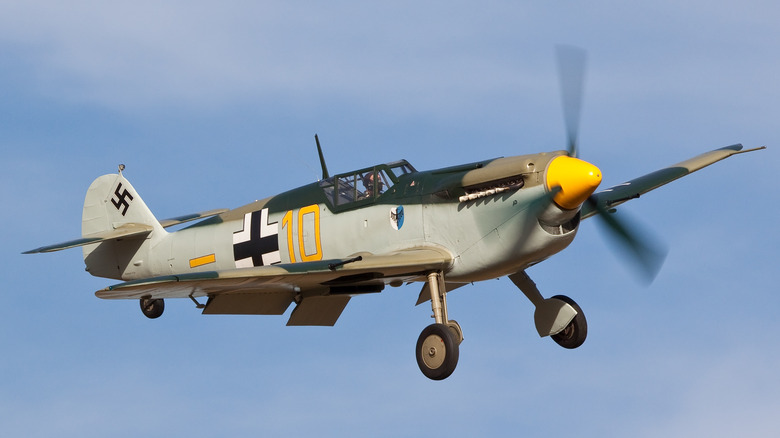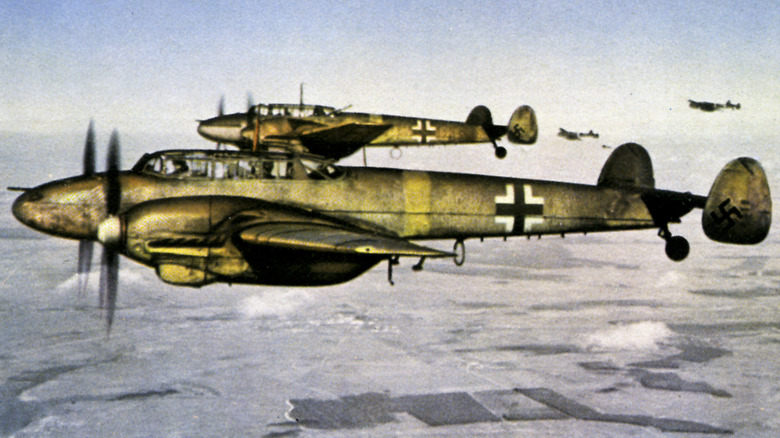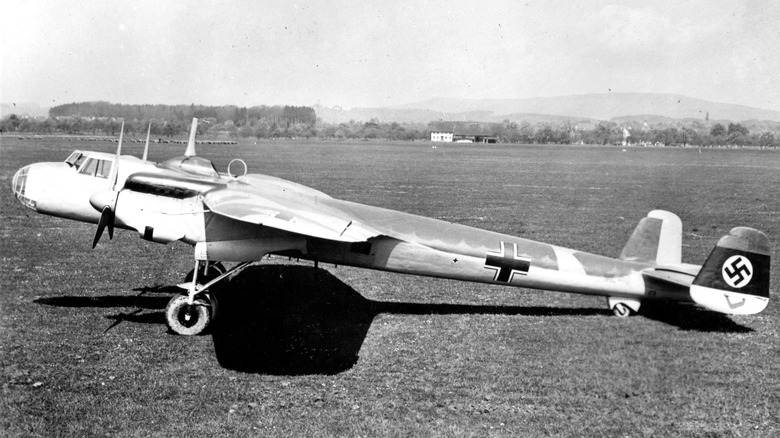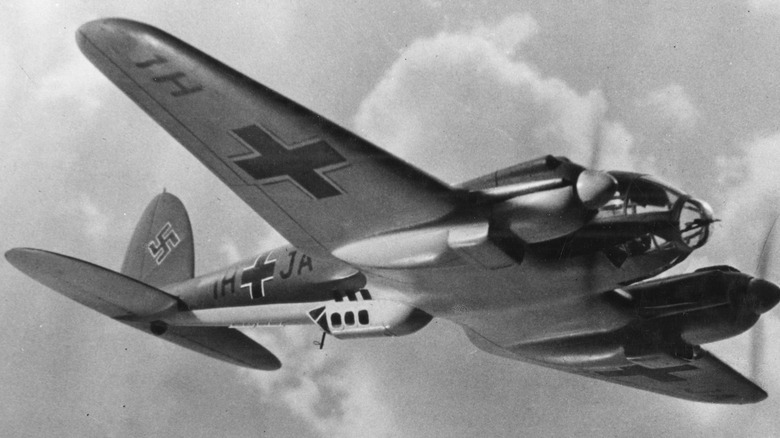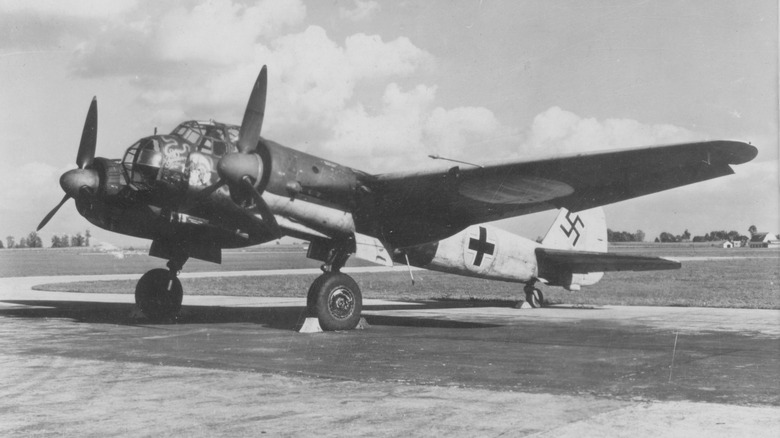9 Of The Most Notable Aircraft That Fought In The Battle Of Britain
Humanity achieved flight a mere decade before the outset of World War I in 1914, and pioneers did not take long to press the revolutionary new science into service. The first fighter pilots fought in cloth and wood biplanes exposed to the elements by taking shots at each other with pistols and dropping bombs by hand. Soon, however, wing-mounted machine guns and the interrupter gear – which allowed bullets to be fired through a propellor — birthed full-fledged aerial dogfighting.
With the concept of air war proven, pilots, engineers, and hobbyists advanced the technology during the interwar years. At the outbreak of World War II 20 years later, planes had advanced to machines of metal and glass, armored plating, and bullet-resistant canopies protecting pilots as they tore at each other with banks of heavy machine guns.
In 1940, Great Britain faced a formidable threat from the German Luftwaffe, led by the former World War I fighter pilot Hermann Goering. Having failed to destroy the English army at Dunkirk, Goering saw an opportunity for redemption by taking the war to England in the skies. The ensuing Battle of Britain would feature some of the most intense aerial dogfighting in history while occurring over England, France, and the Channel that separated them.
The belligerents threw their best young men and newest machines into the fray to see who would master the skies and Europe's fate. The planes they flew were some of the most historically significant and iconic aircraft ever. Join us as we look at the aircraft that fought in the Battle of Britain, one of the most important air battles in history.
Supermarine Spitfire
With its trademark elliptical wings and graceful lines, the Supermarine Spitfire is one of the most recognizable aircraft in history and as much a symbol of British defiance as the English bulldog. The fighter first took flight on March 5, 1936, when Captain Joseph Summers took Spitfire K5054 for its maiden flight. Based on racing seaplanes and designed by Reginald Mitchell, the new fighter seemed destined for greatness from the start. Once he reached the ground, Mitchell's feedback was succinct: "Don't touch anything."
When the Battle of Britain broke out on July 10, 1940, Spitfires accounted for 370 of the 2,000 aircraft in the RAF. Equipped with up to eight .303-inch Browning machine guns and a 1,030 horsepower Merlin engine built by Rolls-Royce, the fighter could reach a maximum speed of around 360 miles per hour and an altitude of 34,000 feet.
As the premier fighter of the RAF, tacticians assigned the pilots to engage with German fighters at high altitudes while the less capable Hawker Hurricane defended Britain from bombers. Above 15,000 feet, the Spitfire was faster and more maneuverable than its primary opponent, the legendary Messerschmitt BF-109. Spitfires accounted for 529 aerial kills during the Battle of Britain while experiencing 361 losses.
The Spitfire remained in production until 1948, for a total of 20,334, with the Mk 24 being the final version of the venerable fighter. Spitfires served in active service in the RAF until 1954 and remains one of the most beloved and iconic aircraft of the aviation age.
Hawker Hurricane
While often overshadowed by the glory of the Spitfire, the Hawker Hurricane was the RAF's fighter workhorse during the Battle of Britain. Evolved from the Hawker Fury, an interwar biplane, the Hurricane took its maiden flight on November 6, 1935. Despite being not quite as bleeding edge as the Spitfire, the Hurricane nonetheless represented an enormous evolutionary step in fighter design and was capable of speeds 100 miles per hour faster than anything the RAF had built before.
The 7,200-pound Hurricane also used a Rolls Royce Merlin powerplant but was significantly slower than the Spitfire, with a maximum speed of 330 miles per hour. The Spitfire also climbed faster than the Hurricane, which led the RAF to relegate the Hurricane to bomber defense while the Spitfires tangled with enemy escorts. Pilots respected the Hawker as a formidable and stable gun platform and a forgiving plane to fly and land — unlike the Spitfire, whose narrow undercarriage increased the possibility of ground looping (which can result in a wing clipping the landing surface) upon landing.
The Hurricane also had the advantage of being relatively fast and straightforward to repair compared to the Spitfire — a crucial consideration in a logistical battle of attrition. More Hurricanes flew in the Battle of Britain than any other British fighter, with 1,715 taking part and claiming 80% of destroyed enemy aircraft between July and October 1940.
Bristol Blenheim
Before the World War II, Germany, which was still under armament restriction thanks to the Treaty of Versailles, developed some of the fastest civilian aircraft designs on the planet. Eager to not let a continental rival upstage them, the British set to designing a fast, six-passenger aircraft of its own. The Bristol Type 142 first flew on April 12, 1935. By the time the Battle of Britain broke out, the aircraft had evolved into the Bristol Blenheim, a nearly obsolete twin-engine aircraft that nonetheless played an important role in the fight.
The Blenheim Mk IV was originally a light bomber, but with England playing defense, as bombing raids weren't on the itinerary for the RAF during the Battle of Britain. Instead, the Blenheim was converted into a night fighter to combat the nighttime bombing raids of the Blitz. Equipped with radar and with four machine guns installed in the fuselage, the Blenheim crew included a pilot, navigator, and dorsal gunner. The Blenheim was outmatched by German machines and suffered significant losses in the battle. Still, its brave crews continued carrying the fight to the enemy against terrible odds.
The Bristol Blenheim was one of the first RAF aircraft to complete a mission during World War II and continued to serve as a bomber, light reconnaissance, and fighter plane for the duration of the war.
Bristol Beaufighter
In many ways, the Beaufighter was the plane the Blenheim wanted to be. From the same manufacturer and similar in appearance, the twin-engine fighter/bomber came a generation after the Blenheim. Its first flight took place on July 17, 1939, mere weeks before the commencement of hostilities.
A pair of 1,560 horsepower Bristol Hercules XI engines powered the Mark I version. The warbird had an altitude ceiling of 29,000 feet, a range of 1,500 miles, and a top speed of 320 miles per hour. Compared to contemporary craft like the Hurricane and Spitfire, the Beaufighter was incredibly well-armed. In addition to six .303 machine guns in the wings, two 20-millimeter Hispano cannons gave the Beaufighter extra sting. The Beaufighter also served as a light bomber capable of carrying a quartet of 500-pound bombs.
During the Battle of Britain, Beaufighters played a crucial role in successful night fighting, thanks to the installation of the ultra-secret Airborne Interception Radar. These Mk IF night fighters eventually equipped RAF Squadron Nos. 25, 29, 219, 600, and 604 for duty in England. When the war shifted back to Europe, Beaufighters continued to make history, playing a major role in the Mediterranean.
Messerschmitt Bf 109
The Messerschmitt Bf 109 was the Luftwaffe's primary fighter plane for the duration of the war. The prototype flew in 1935, shortly after Hitler decreed the prohibition on aircraft production levied by the Treaty of Versailles to be null. Germany's nascent aviation industry was young but innovative. By 1937, the Luftwaffe was ready to deploy the Bf 109 to the Spanish Civil War for real-world testing.
It was the redesigned E variant of the Bf 109 that saw action in the early stages of the war, including the Battle of Britain, had a top speed of 350 miles per hour and an operational ceiling of 36,000 feet. It was a competent climber and diver, outclassing its main nemeses, the Hurricane and Spitfire, and was equipped with two cowl-mounted machine guns along with two 20 mm cannons in the wings.
The Bf 109E was the only single-seat fighter used by the Germans during the Battle of Britain. While it suffered from reduced range due to a small fuel tank compared to the British fighters, it far outperformed in ammunition capacity — a Spitfire pilot had about 15 seconds worth of ammunition in his plane, while his Messerschmitt rival had 55 seconds of firing before running dry.
Based on airfields in continental Europe, Bf 109s escorted German bombers on runs to hammer England. Despite it's strong performance figures, the stalwart British pilots and English innovations in radar technology meant that the Bf 109E never gained the air superiority it needed to win the Battle of Britain.
Messerschmitt Bf 110
Originally designed as a long-range escort fighter, the Bf 110 suffered so severely against the nimble Spitfires and Hurricanes of the RAF that it was converted to night-fighting duty for the rest of the war after the Battle of Britain.
With a pair of Daimler-Benz DB 601 engines and a two-man crew, the Bf 110 was a heavy and less maneuverable aircraft than single-seat ones. This characteristic was a significant challenge for German pilots during the Battle of Britain. In August 1940, the peak of the battle, over 120 Bf 110s were shot down.
The lessons learned in the Battle of Britain by the German command saw the Bf 110 converted to a night fighter, a role in which it met success. It saw action in the Mediterranean and Eastern Front theaters, scoring kills and harassing the enemy with bombs during night actions. Germany produced over 6,000 Bf 110s throughout the war, but only two intact specimens are believed to exist today.
Dornier Do-17
The British primarily required fighter aircraft to defend against German incursions, but Germany employed a variety of bombers in its attack. The Dornier Do-17 was one of the primary German bombers of the Battle of Britain, with over 400 participating.
French-German aircraft designer Claudius Dornier, who was 27 at the time, designed the first all-metal plane in 1911. The design impressed his superiors at the Zeppelin Airship Factory so much that they appointed him head of his own division. Dornier aircraft flew in World War I, after which Dornier took control of the factory and forged onward.
Nicknamed the flying pencil for its slim fuselage, the Do-17 first flew in 1943 in a bid for a passenger aircraft contract with Lufthansa. Failing to win the contract, the Do-17 was converted to military use. The Do-17Z, the version that fought in the Battle of Britain, was powered by a pair of supercharged Bram 323P-1 nine-cylinder radial engines. Crewed by a pilot, navigator, and flight engineer, its armament of three to four 7.92 mm MG17 machine guns faced forward, making the bomber exceptionally vulnerable to attack from the flanks and rear.
Germany's enormous military success in the first months of the war against inferior air power caused the command to overestimate the Luftwaffe's capability, and the Do-17 suffered from this miscalculation. While the bombers that made it to the target rained terror on the cities of Britain, the Do-17 was retired in 1941, having been proven obsolete over the Channel.
Heinkel He 111
Ernest Heinrich Heinkel was an aviation dynamo. After the first plane he designed crashed in 1910, the aeronautical engineer and founder of the Ernst Heinkel Flugzeugwerke – the legendary German aircraft factory — set world records with his He 70 and pioneered reaction motors and turbojets.
The He 111 was a medium bomber designed by Heinkel engineers Siegfried and Walter Gunter that was significantly involved in the Battle of France, the Battle of Britain, and the Blitz. Like the D0-17, it started life as a failed civilian contract. Originally envisioned as an airliner, increased militarism after the rise of Hitler turned it into a war machine.
Built between 1935 and 1944, the He 111 had a combined 2,680 horsepower provided by tandem Jumo 211-F in-line engines. With a maximum speed of 292 miles per hour and a potential bomb load of 4,400 pounds, the medium bomber was considered insufficient for carpet bombing attacks. This became especially apparent when compared to the Allied heavy bombers that appeared later in the war with payloads of 13,000 to 18,000 pounds.
The first bombs to strike London on August 24, 1940 fell from He 111s. A wayward patrol sent to bomb the Rochester and Thames Haven oil terminal hit the city by mistake, igniting a bombing brinksmanship that would see the wholesale destruction of cities across Europe during the war.
Junkers Ju 88
The Junkers Ju 88 was the core of the Luftwaffe bomber service. It served as a night fighter, dive bomber, interceptor, reconnaissance photographer, tank destroyer, and conventional bomber. The Ju 88 operated in every theater in which the Germans deployed air forces and played a role in the bombing of England during the Blitz.
From its inception, the Ju-88 was intended as a military aircraft. In August 1935, the German government asked companies to submit plans for a high-speed medium bomber. The first prototype took flight in December 1936. Its record-breaking top speed of 300 miles per hour encouraged the government to select the Junkers design. However, production experienced considerable delays when Goering insisted it needed to be capable of dive bombing.
The final product could carry a payload of 5,500 lbs. of bombs, packing them in the bomb bay while retaining external mounts for torpedoes and other arms. The most heavily armed Ju-88s had six 7.92 mm machine gun emplacements, four facing the rear and two facing the front.
The delayed Ju 88 arrived in September of 1939, just in time for the war. It got its first chance to participate in major operations as a daylight raider during the Battle of Britain. Its primary target mission was to bomb radar stations, coastal defenses, airfields, and ports along the British coastline. The Battle of Britain marked the beginning of its service life, and Germany increased production afterward to replace those lost to British fighters.
